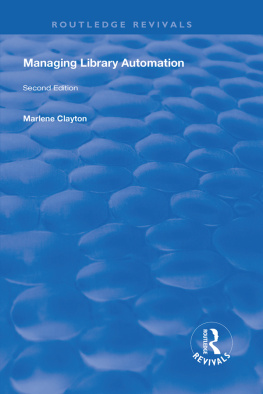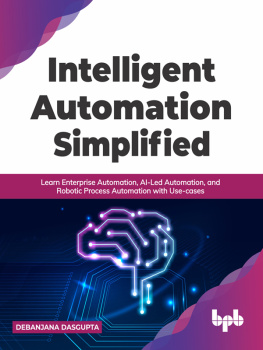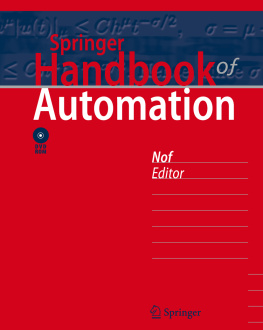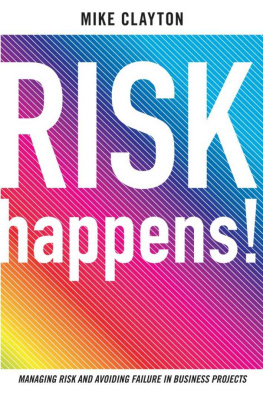Marlene Clayton - Managing Library Automation
Here you can read online Marlene Clayton - Managing Library Automation full text of the book (entire story) in english for free. Download pdf and epub, get meaning, cover and reviews about this ebook. year: 1987, publisher: Gower Publishing Company, genre: Politics. Description of the work, (preface) as well as reviews are available. Best literature library LitArk.com created for fans of good reading and offers a wide selection of genres:
Romance novel
Science fiction
Adventure
Detective
Science
History
Home and family
Prose
Art
Politics
Computer
Non-fiction
Religion
Business
Children
Humor
Choose a favorite category and find really read worthwhile books. Enjoy immersion in the world of imagination, feel the emotions of the characters or learn something new for yourself, make an fascinating discovery.
- Book:Managing Library Automation
- Author:
- Publisher:Gower Publishing Company
- Genre:
- Year:1987
- Rating:4 / 5
- Favourites:Add to favourites
- Your mark:
- 80
- 1
- 2
- 3
- 4
- 5
Managing Library Automation: summary, description and annotation
We offer to read an annotation, description, summary or preface (depends on what the author of the book "Managing Library Automation" wrote himself). If you haven't found the necessary information about the book — write in the comments, we will try to find it.
Managing Library Automation — read online for free the complete book (whole text) full work
Below is the text of the book, divided by pages. System saving the place of the last page read, allows you to conveniently read the book "Managing Library Automation" online for free, without having to search again every time where you left off. Put a bookmark, and you can go to the page where you finished reading at any time.
Font size:
Interval:
Bookmark:
Library
Automation

2 Park Square, Milton Park, Abingdon, Oxon OX14 4RN
711 Third Avenue, New York, NY 10017, USA
Product or corporate names may be trademarks or registered trademarks, and are used only for identification and explanation without intent to infringe.
The publisher has gone to great lengths to ensure the quality of this reprint but points out that some imperfections in the original copies may be apparent.
ISBN 13: 978-0-429-44906-2 (ebk)
| AACR | Anglo-American Cataloguing Rules |
| ADONIS | Article Delivery Over Network Information Service |
| AFR | automatic format recognition |
| AGRIS | International System for the Agricultural Sciences and Technology |
| ANSI | American National Standards Institute |
| ASR | automatic send-receive |
| BEDIS | Book Trade Electronic Data Interchange Standards Committee |
| BIC | Book Industry Communications |
| BIDS | Bath ISI Data Service |
| BISAC | Book Industry Systems Advisory Committee |
| BLDSC | British Library Document Supply Centre |
| BNB | British National Bibliography |
| BTECC | Book Trades Electronic Communications Committee |
| CAD | computer-aided design |
| CAL | computer-assisted learning |
| CAR | computer-assisted retrieval |
| CCF | common communication format |
| CCITT | Comit Consultatif International de Telephonie et de Tlgraphie |
| CCL | Common Command Language |
| CCTA | Central Computer and Telecommunications Agency |
| CD | compact audio disk |
| CDI | Compact Disk Interactive |
| CD-ROM | compact disk read-only memory |
| CDTV | Commodore Dynamic Total Vision |
| CDXA | Compact Disk eXtended Architecture |
| CEPT | Confrence Europene des Administrations des Postes et TlTcommunications |
| CIP | Cataloguing-in-Publication |
| CLR | Council on Library Resources |
| CNRS | La Centre Nationale de la Recherche Scientifique |
| COM | computer output microform |
| CPM | Critical Path Method |
| CPU | central processing unit |
| CRT | cathode ray tube |
| CSMA/CD | carrier sense multiple access with collision detection |
| CURL | Consortium of University Research Libraries |
Font size:
Interval:
Bookmark:
Similar books «Managing Library Automation»
Look at similar books to Managing Library Automation. We have selected literature similar in name and meaning in the hope of providing readers with more options to find new, interesting, not yet read works.
Discussion, reviews of the book Managing Library Automation and just readers' own opinions. Leave your comments, write what you think about the work, its meaning or the main characters. Specify what exactly you liked and what you didn't like, and why you think so.













